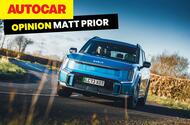The irritations of flying makes it more appealing to drive to and from Europe, argues Prior
Steve Cropley recently said he’d rather have driven than flown home from an event, even though it would have taken longer. He absolutely, resolutely, talked my language.
As I write I’m on an aeroplane. I love planes, enjoy being in the air and think modern aviation is one of humankind’s greatest achievements, shrinking the planet, letting us share knowledge, culture, you name it, like never before.
Yet it also gets on my tits like you wouldn’t believe because the experience is being continually pared back until it’s as close to the line marked ‘just bearable’ as customers will stomach.
Compare that with what the car industry tries to do. A new car won’t be more sparse than its predecessor.
Every iteration will offer more features, more refinement, more polish, more ‘stuff’ whether you truly want it or not, and I think that counts for something.
There are regulators and policy makers who, it feels to me, are trying to make the experience of driving as miserable as possible.
But in a car, I always feel more in charge of my destiny, and that I’m in something whose creators and vendors, at least, want me to have a good time.
Noises off
In case you find new car tech obstructive and think nobody’s listening, here’s a heartening tale from Kia, which had come in for some stick over the way it had set up bongs for this, that and the other, to comply with the latest round of safety regulation requirements, GSR2.
Warning bongs for speed limit breaches, frequently called wrongly, and bongs accompanying speed limit changes, even though you can (and in fact must) spot them through your windscreen, were particularly annoying and ranged from difficult to nigh-on impossible to switch off.
But you and I complained, and Kia listened. In an over-the-air update for the latest Sorento and EV9, the audible speed limit warnings are now easier to disable (and, as importantly, re-enable), by pressing and holding the mute button on the steering wheel.
This will turn the audible warnings off, or back on again should you want the extra help. Visual cues remain.
And the bongs default to being on, as they must every time the car’s started, according to regulations.
Manufacturers are starting to get a handle on how customers prefer to use these systems, many of which are still too fallible to be left alone.
How did it go, elon?
Elon Musk, boss of Tesla, seems to have changed his mind about concept cars.
“Really hate it when companies bring out an awesome new show car and then you can never actually buy it,” he said on Twitter in 2015. “So lame.”
With those sentiments still relatively fresh in the mind, just two years later, in 2017, we were first teased the idea of a second-generation Tesla Roadster. But you still can’t buy one today, so sentiments clearly have changed.
There have been other bold Tesla pronouncements since too, some of which have entered the market, like the Cybertruck, and others, like unsupervised Full Self-Driving, which as yet have not.
Then, last week, Musk announced the creation of, and climbed into, a new Cybercab, a two-seat autonomous minicab with painted tyres to make the wheels look bigger, driven in a very controlled environment. Musk said it will be available in 2027.
Tesla has achieved remarkable things since its inception. And many of the company’s bolder pronouncements have, historically, been good for the company’s share prices. But not this one.
After the robotaxi event, Tesla rapidly shed more than £50 billion from its stock value.
Musk might have changed his tune about demonstrating cars you can’t actually buy, but investors seem to have come around to his earlier way of thinking.







